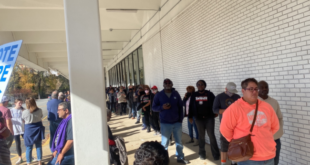Malliga Och, Ms.
Originally published by The 19th
Since the Supreme Court’s Dobbs v. Jackson Women’s Health Organization decision gave states the authority to decide whether people can access legal abortions, state supreme courts are emerging as vital arenas in the battle over bodily autonomy.
The high courts in Florida, South Carolina, Georgia and Iowa upheld six-week abortion bans. The Texas Supreme Court denied an abortion to a woman whose fetus had a fatal condition. The North Dakota court ruled that abortions are legal only if they protect a pregnant person from death or serious health risk. Alabama ruled that embryos are children, briefly halting in vitro fertilization in the state. In 2023, the Wisconsin Supreme Court shifted to a 4-3 majority poised to protect abortion rights after Justice Janet Protasiewicz won her race by highlighting her support of abortion rights.
According to the Center for Reproductive Rights, 30 states have heard cases challenging abortion restrictions. The supreme courts in 11 states have recognized abortion rights under their state constitutions; five courts have come to the opposite conclusion. Beyond the constitutionality of abortion bans, state supreme courts also decide how to interpret the medical exceptions within these laws. According to Alexander Wilson, a staff attorney at the Center for Reproductive Rights, the organization has been working hard to get clarification from courts about the exceptions.
Without proper clarification, “people’s lives are at risk because [doctors] are left to choose between facing significant penalties or providing care,” Wilson said.
Currently, cases seeking to clarify the scope of medical exceptions are winding their way through the court systems in Utah, Wyoming, North Dakota, Idaho and Tennessee. All of these cases are likely to end up at the states’ highest courts.
State supreme court elections are no longer down-ballot, low-information races. Today, with the high stakes of reproductive rights on the line, these races are pivotal.
This November, 83 judicial seats are up for an election or retention vote across 33 states, according to Ballotpedia. This number includes judges who voted to uphold abortion bans in Florida and Arizona.
In November 2023, 57 percent of Ohio voters approved Issue 1, a constitutional amendment protecting abortion. Despite that vote, the Ohio legislature’s conservative majority is hindering the amendment’s implementation. While Ohio’s six-week abortion ban is now unenforceable under Issue 1, approximately 30 restrictions are still on the books, with Ohio lawmakers defending them as constitutional regardless of the new amendment. Without action by the legislature to rescind all the restrictions outright, each must be challenged in court. Because the cases will be brought on state constitutional grounds, the Ohio Supreme Court will have the final say.
Currently the court has a 4-3 conservative majority. But three seats are up for a vote in November. Under a law enacted in 2021, judicial candidates must run with party labels, further highlighting the partisan stakes of the 2024 election. The fight over Issue 1 showed that abortion rights garner broad support across Ohio.
But Jessie Hill, a law professor at Case Western Reserve University, said that Ohio is still a red state, so “if people are continuing to just vote on party lines [this] really favors Republicans. … The real question in this election is … are we going to have justices on that Ohio Supreme Court who are willing to respect and fulfill the promise of that amendment?”
While none of the Democratic candidates for the Ohio court are explicitly running on abortion rights, they could learn a lesson from Protasiewicz in Wisconsin, who drew the highest voter turnout in 12 years for a spring election in a year without a presidential primary — in particular, it was young voters coming out to support abortion rights who proved pivotal.
Michigan voters approved Proposition 3, enshrining abortion rights in the state constitution, in 2022. Democrats currently hold a 4-3 majority on Michigan’s Supreme Court, but two incumbents — a conservative Republican and a liberal Democratic justice — are up for reelection. If Republicans win both seats, the court will swing right. This same court will hear several legal challenges to abortion restrictions under Proposition 3, meaning its composition is crucial to guaranteeing comprehensive abortion protections in Michigan.
Both Ohio and Michigan highlight the important role of state supreme courts in the battle to keep abortion legal. Even if states enact constitutional amendments to protect abortion, the courts will ultimately decide how broadly or narrowly these protections are applied. In a post-Dobbs world, state supreme courts have become the last bastion of defense against anti-abortion efforts.
The supreme court race in North Carolina offers insights about the importance of a forward-looking strategy. Currently, North Carolina has a complicated patchwork of abortion bans and restrictions, with the Supreme Court yet to decide whether the state constitution protects the right to abortion. Before the 2020 election, liberal judges held a 6-1 majority on the court. Through a concerted effort by conservatives, the court swung from left to right beginning that year, when conservative judges won three seats. This paved the way for a 5-2 conservative majority in 2022.
This year, one crucial seat is up for grabs, offering a chance to expand liberal representation and laying the foundation to recapture the court from conservatives in 2028. Democratic Gov. Roy Cooper appointed Justice Allison Riggs to the court in 2023 and now she is running for a full term. She is pitted against Judge Jefferson Griffin, who ruled in a 2023 case that life begins at conception. If Riggs wins this November and if current Justice Anita Earls can hold on to her seat in 2026, a liberal majority will be possible. If Riggs loses, conservatives will reach a 6-1 majority.
Whether or not abortion rights are directly on the ballot, voters in the 33 states with state supreme court elections will shape the future of abortion access. These justices, as the ultimate arbiters of state constitutional law, will decide on medical exceptions, state constitutional protections for abortion and the possibility of future ballot initiatives.
 Poli Alert Politics & Civics
Poli Alert Politics & Civics



